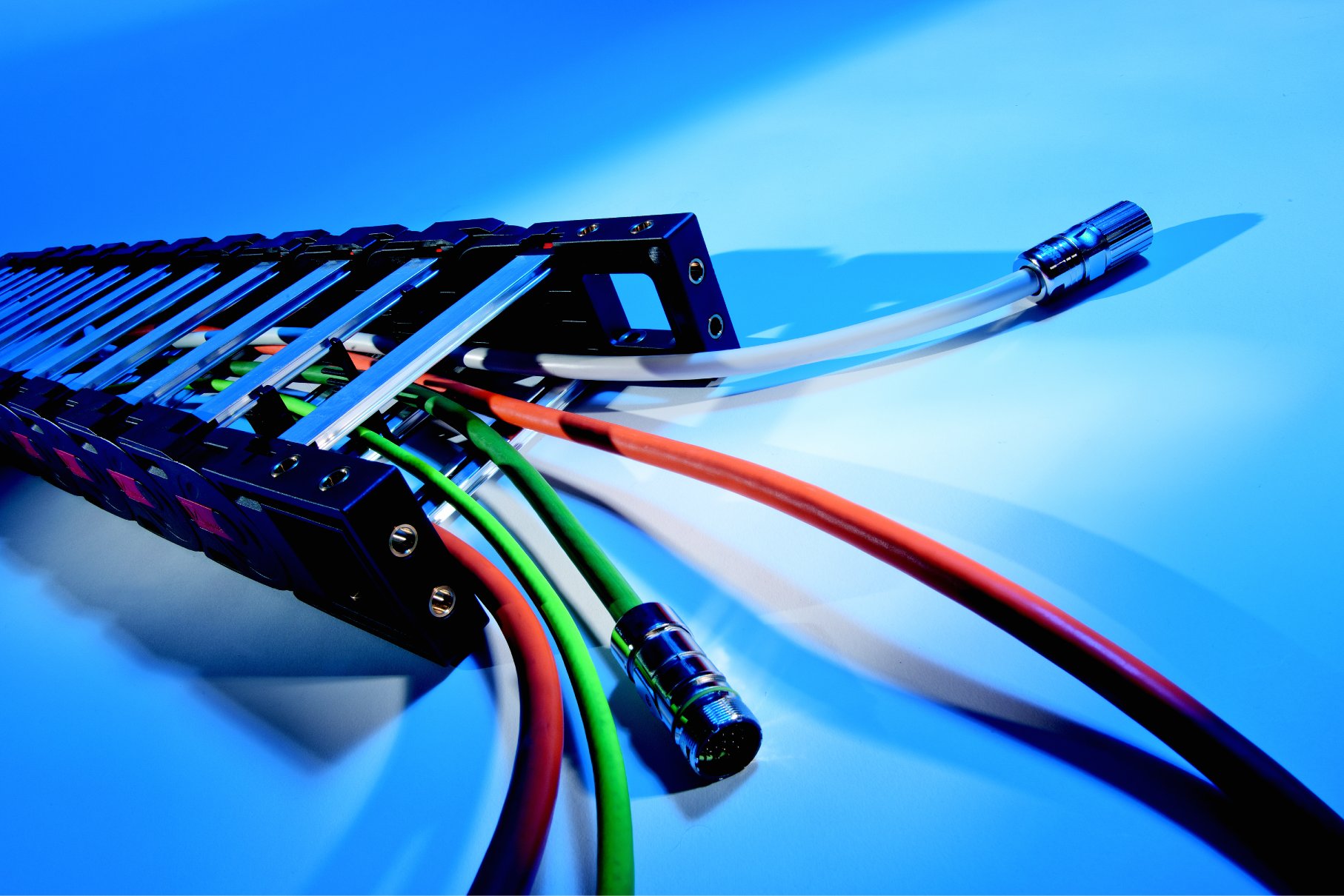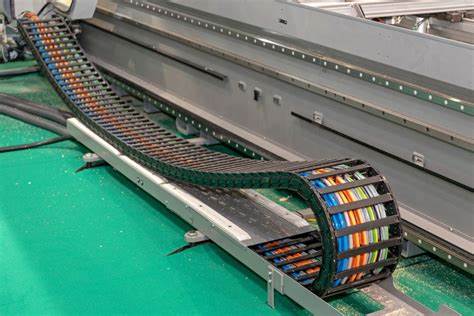

Zəncir kabelləri sürükləyin, Kabel daşıyıcıları və ya enerji zəncirləri kimi də tanınır, Kabellərin davamlı hərəkətə məruz qaldığı dinamik tətbiqlərin ciddi tələblərinə tab gətirmək üçün hazırlanmış xüsusi kabellərdir. Bu kabellər təkrarlanan çevikliyə dözmək üçün hazırlanmışdır, əyilmə, və bükülmə, müxtəlif sənaye və robot tətbiqlərdə onları əvəzsiz hala gətirmək. Bu hərtərəfli təlimatda, Veri kabel araşdıracaq SHAG zəncir kabelləri nədir, Necə işlədirlər, və optimal performans və uzunömürlülük təmin etmək üçün onlardan istifadə üçün ən yaxşı təcrübələr.


Drag zəncir kabelləri, davamlı hərəkətin tələb olunduğu mühitlərdə işləmək üçün xüsusi olaraq hazırlanmış kabellərdir. Standart kabellərdən fərqli olaraq, sürükleyin zəncir kabelləri, performansda zərər və ya deqradasiya edilmədən minlərlə və ya milyonlarla təkrarlanan hərəkət dövrünə dözə bilər. Bu kabellər sürük zəncirləri ilə birlikdə istifadə olunur, kabelləri istiqamətləndirən və qoruyan mexaniki sistemlərdir, Tancinqin qarşısını alır, Həddindən artıq aşınma, və dinamik tətbiqlərdə potensial təhlükələr.
Zəncirvari kabelləri standart kabellərdən fərqləndirən bir neçə əsas xüsusiyyətə malikdir:
Drag zəncir kabelləri, maşın və avadanlıqların etibarlı və davamlı hərəkət tələb etdiyi müxtəlif sahələrdə istifadə olunur. Ən çox yayılmış tətbiqlərdən bəziləri daxildir:
Drag zəncir kabelləri müxtəlif növlərə gəlir, Hər biri xüsusi tətbiq və mühit üçün hazırlanmışdır. Drag Chaineber Cables-in müxtəlif növlərini başa düşmək ehtiyaclarınız üçün düzgün birini seçməyə kömək edə bilər.
Tək əsaslı sürükləmə zəncir kabelləri izolyasiya edən bir material daxilində bir dirijordan ibarətdir. Bu kabellər, yerin məhdud olduğu tətbiqlərdə adətən istifadə olunur, və yalnız tək elektrik bağlantısı tələb olunur. Onlar tez-tez kiçik robot sistemlərində və yığcam maşınlarda olur.
Çox nüvəli sürüklü zəncir kabellərində bir çox dirijor var, hər biri ayrı-ayrılıqda, və bir xarici bir qabıq daxilində. Bu kabellər çox elektrik bağlantısını tələb edən tətbiqlər üçün idealdır, məsələn, CNC maşınları və mürəkkəb robot sistemlərində.
Məlumat və Siqnal Drag Chainebable Kabelləri, aşağı gərginlikli siqnalları yüksək sədaqətlə ötürmək üçün hazırlanmışdır. Bu kabellər tez-tez EMI'nin qarşısını almaq üçün qorunur, siqnal bütövlüyünün kritik olduğu tətbiqlərə uyğun olmaq, Tibbi avadanlıqlarda və dəqiq alətlərdə olduğu kimi.
Power Drag Chaine kabelləri yüksək gərginlik və cari maşın və avadanlıqlara ötürmək üçün istifadə olunur. Bu kabellər ağır tətbiqi idarə etmək üçün hazırlanmışdır və tez-tez əlavə izolyasiya və qorunma qatları ilə güclənir.
Hybrid Drag Chaine kabelləri bir kabel içərisində çoxsaylı növləri birləşdirir. Misal üçün, Hibrid kabelin gücü daxil ola bilər, data, və siqnal keçiriciləri, mürəkkəb maşın və sistemlər üçün çox yönlü bir həll etmək.
Tətbiqiniz üçün sağ sürük zəncir kabelinin seçilməsi bir neçə amili nəzərdən keçirməyi əhatə edir. Səhv seçim vaxtından əvvəl kabel çatışmazlığına səbəb ola bilər, bahalı iş vaxtı, və təhlükəsizlik təhlükələri. Budur sağ sürük zənciri kabelini seçməyə kömək etmək üçün bir addım-addım bələdçi.
Tətbiqinizin konkret tələblərini qiymətləndirərək başlayın. Hərəkət növü kimi amilləri nəzərdən keçirin (əyilmə, burulma, ya da hər ikisi), Əməliyyat sürəti, səyahət uzunluğu, və ətraf mühit şəraiti (temperatur, rütubət, kimyəvi məruz qalma).
Tətbiq tələblərinə əsasən, ehtiyacınız olub olmadığını müəyyənləşdirin birtərəfli, çox nüvəli, data, siqnal, güc, və ya hibrid kabel. Misal üçün, Yüksək gərginlik ötürmək lazımdırsa, Bir elektrik kabeli düzgün seçimdir, Bir məlumat kabeli aşağı gərginlikli siqnal ötürülməsi üçün ən yaxşısıdır.
Çək Zəncir Kabelləri müxtəlif səviyyələrdə rahatlıq içində mövcuddur. Bükülmə radiusu, kabelin daxili dirijorlara zərər vermədən əyilə biləcəyi minimum radiusdur. Seçdiyiniz kabelin tətbiqinizə uyğun əyilmə radiusuna sahib olmasını təmin edin. Tətbiqiniz sıx əyilmələri əhatə edirsə, Daha kiçik bir əyilmə radiusu olan bir kabel seçin.
Tətbiqiniz bükülmə hərəkətləri ehtiva edirsə, yüksək tortional gücü olan sürük zəncir kabeli seçin. Bu, kabelin daxili zərər və ya dirijor pozuntusundan əziyyət çəkmədən bükülmə hərəkətini idarə edə biləcəyini təmin edəcəkdir.
Kabelin istifadə ediləcəyi ətraf mühit şərtlərini nəzərdən keçirin. Kabel kimyəvi maddələrə məruz qalacaqsa, yağlar, və ya həddindən artıq temperatur, Bu şərtlərə tab gətirə biləcək bir qabıq materialı olan bir kabel seçin. əlavə olaraq, Kabel açıq tətbiqlərdə istifadə edilərsə, Uv davamlı olduğundan əmin olun.
Həmişə Çəkmə Zəncir Kabeli üçün istehsalçının xüsusiyyətlərini və tövsiyələrini nəzərdən keçirin. Buraya kabelin idarə edə biləcəyi maksimum dövrlərin sayı daxildir, Temperatur aralığı, əyilmə radiusu, və EMI qorunması üçün qorunma kimi hər hansı bir xüsusi xüsusiyyət.
Zəncirvari kabelin hansı sürükleyin seçilməsinə əmin deyilsinizsə, ilə məsləhətləşmək Mütəxəssislər və ya kabel istehsalçısı. Xüsusi tətbiq ehtiyaclarınıza əsasən dəyərli anlayışlar və tövsiyələr verə bilərlər.
Drag zəncir kabellərinin düzgün quraşdırılması onların uzunömürlülüyünü və performansını təmin etmək üçün çox vacibdir. Çək Zəncir kabelləri quraşdırarkən izləmək üçün bəzi ən yaxşı təcrübələr var:
Çəkən zəncirdən əmin olun (kabel daşıyıcısı) istifadə etdiyiniz sürük zəncir kabeli ilə uyğun gəlir. Sürük zənciri kabelin sıxılmış və ya məhdudlaşdırmadan sərbəst hərəkət etməsi üçün lazımi yer təmin etməlidir. əlavə olaraq, sürük zənciri kabelin ağırlığını və içərisində olan hər hansı digər komponentləri dəstəkləməlidir.
Quraşdırma zamanı, Kabelin tövsiyə olunan əyilmə radiusundan kənarda əyilmədiyindən əmin olun. Əyilmə radiusunun aşması dirijorlara daxili ziyan vura bilər, vaxtından əvvəl kabel çatışmazlığına aparan.
Sürüşmə zənciri içərisində sürüşməməsi və ya hərəkət etməsinin qarşısını almaq üçün hər iki ucunda kabeli etibarlı edin. Lakin, Kabeli çox sıxmaqdan çəkinin, Bu, izolyasiya və daxili keçiricilərə ziyan vura bilər.
Sürük zəncirini çox sayda kabellə aşmaq hərəkəti məhdudlaşdıra və kabellərdə həddindən artıq aşınmaya səbəb ola bilər. Çəkmə zəncirinin maksimum doldurma qabiliyyəti üçün istehsalçının təlimatlarını izləyin.
Quraşdırma zamanı, Kabelin sürükləmə zənciri daxilində düzgün uyğunlaşdırılmasını təmin edin. Misalignment kabeldə lazımsız stresə səbəb ola bilər və vaxtından əvvəl aşınma və göz yaşı tökə bilər.
Təmizləmə əlamətləri üçün sürükləmə zəncir kabellərini mütəmadi olaraq yoxlayın, ziyan vurmaq, və ya uyğunsuzluq. Gündəlik təmir kabel çatışmazlığına səbəb olmayaraq potensial problemləri müəyyənləşdirməyə kömək edə bilər, Davamlı və etibarlı bir əməliyyat təmin etmək.
Yanlışdan istifadə edərək sürükləmə zəncir kabelləri müxtəlif məsələlərə səbəb ola bilər, Kabel çatışmazlığı da daxil olmaqla, Maşın iş vaxtı, və təhlükəsizlik təhlükələri. Qaçmaq üçün bəzi ümumi səhvlər var:
Ən çox görülən səhvlərdən biridir tətbiqlərdə standart kabellərdən istifadə sürükvari zəncir kabelləri tələb edir. Standart kabellər davamlı hərəkətə tab gətirmək üçün hazırlanmır və bu cür mühitlərdə vaxtından əvvəl olmayacaqdır.
Tövsiyə olunan əyilmə radiusunun aşması kabel çatışmazlığının tez-tez səbəbidir. Daxili dirijor zərərinin qarşısını almaq üçün kabelin düzgün əyilmə radiusu ilə quraşdırılmasını həmişə təmin edin.
Sürük zəncirini çox kabel ilə həddindən artıq yükləmək və ya tətbiq üçün çox kiçik olan bir sürük zəncirindən istifadə edərək kabel ziyanına və məhdud hərəkətə səbəb ola bilər. Həmişə aparacaq kabellər üçün uyğun ölçülü bir sürük zəncirindən istifadə edin.
Kabelin istifadə ediləcəyi ətraf mühitin şərtlərini nəzərə almamaq üçün vaxtından əvvəl kabel çatışmazlığına səbəb ola bilər. Kabelin qabığının ətraf mühitə uyğun olduğundan əmin olun, Xüsusilə kabel məruz qalacaqsa kimyəvi maddələr, yağlar, və ya həddindən artıq temperatur.
Sonda və ya sürük zənciri boyunca kabelin yanlış şəkildə təmin edilməsi kabelin hərəkətinə və ya sürüşməsinə səbəb ola bilər, Geyinməyə və potensial uğursuzluğa səbəb olur. Kabelin çox sıx olmadan düzgün təmin olunduğundan əmin olun.
Sənayelər irəliləməyə davam etdikcə, Daha mürəkkəb və davamlı sürükləmə zəncir kabellərinin tələbi artacaq. Materiallarda yeniliklər, layihə, və istehsal proseslərinin daha da ekstremal şəraiti həll edə biləcək sürük zəncir kabellərinin inkişafı gözlənilir, daha yüksək sürətlə, və daha mürəkkəb hərəkətlər. əlavə olaraq, Ağıllı texnologiyaların inteqrasiyası, sensorlar və monitorinq sistemləri kimi, Çəkmə zənciri kabelləri kabel performansında real vaxt məlumatları verə bilər, etibarlılığını və ömrünü daha da artırır.
Ding Sweet Cables, dinamik tətbiqlərdə maşın və avadanlıqların etibarlı işləməsini təmin etmək üçün kritik rol oynayır. Sürük zəncir kabellərinin nə olduğunu başa düşməklə, Necə işlədirlər, və istifadə üçün ən yaxşı təcrübələr, Kabellərinizin uzunmüddətli performans təmin etdiyini və iş vaxtı və texniki xidmət xərclərini minimuma endirməyə kömək edə bilərsiniz.
Çəkmə zəncir kabellərini seçərkən və quraşdırarkən, Həmişə tətbiqinizin xüsusi tələblərini nəzərdən keçirin, hərəkət növü daxil olmaqla, Ətraf mühitin şərtləri, və əyilmə radiusu. Təlimatları izləmək və ümumi səhvlərdən qaçınmaqla, Çəkən zəncir kabellərinizin ömrünü maksimum dərəcədə artıra və maşınlarınızın hamar və səmərəli işləməsini təmin edə bilərsiniz.
Texnologiya inkişaf etməyə davam etdikcə, belə sürükləmə zəncir kabellərinin imkanları da olacaq, Gələcək illərdə daha böyük performans və etibarlılığı təklif edir. Robototexniklərdə olsanız da, istehsal, və ya dinamik hərəkətə güvənən hər hansı digər sənaye, Çəkmə zəncir kabellərini səmərəli şəkildə istifadə etmək və istifadə etmək, rəqabət kənarını qorumaq üçün vacibdir.
İnsanlar mineral izolyasiya edilmiş kabel termini eşitdikdə, many immediately think of harsh environments like…
Telekommunikasiya şəbəkələri və enerji ötürücü sistemləri sürətlə böyüyür, the demand for reliable and cost-effective…
Güclü neft və qaz layihələrində, Sənaye kabelləri yalnız aksesuar deyil—they are the "nervous…
Elektrik bağlantıları dünyasında, kabel qapaqları—Kabel qulaqları və ya kabel terminalları kimi də tanınır—var…
Elektrik mühəndisliyi layihəsi üçün düzgün rezin kabel seçərkən, it is critical to…
Əziz tərəfdaşlar və müştərilər: 29 yanvar, 2025 Çin Aysal Yeni ilidir – Spring…